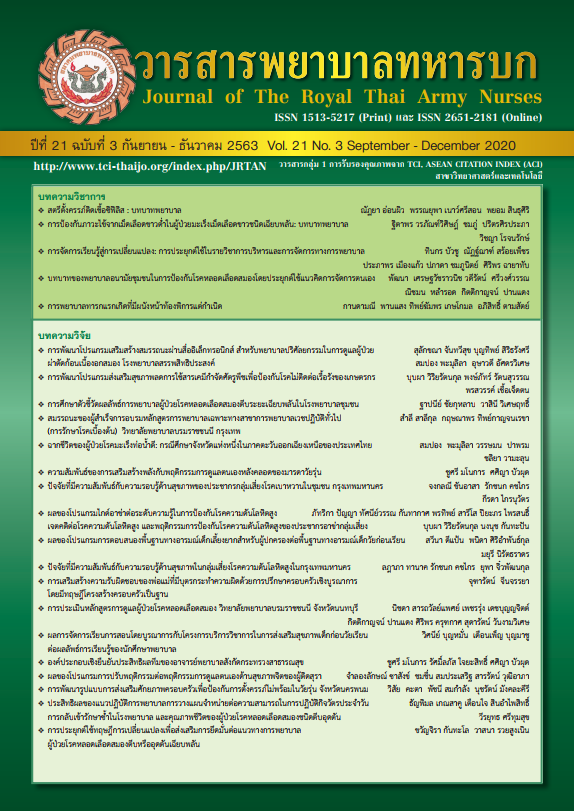Nursing Care for Neonate with Gastroschisis
Keywords:
nursing care for neonate, gastroschisisAbstract
Gastroschisis is an abnormal condition of neonate with a hole in the congenital abdominal wall. It results from an abnormality in the umbilical vein or a ruptured umbilical hernia sac. It defects the anterior abdominal wall in every layer. Therefore, the intestine protrudes from the abdominal wall and is swollen, inflamed, or infected. The doctor can detect this condition in the antenatal period and after delivery. After birth, preventing hypothermia, infection, and lack of water and nutrients is very important. After the abdominal wall closed surgery, nursing care focuses on preventing hypoxia due to decreased breathing efficiency. It can occur because of re-entering the intestine into the abdomen cavity. That can make the chance of increased intra-abdominal pressure. The register nurses have to monitor the abdominal compartment syndrome, wound infection, and lack of water and nutrition due to the dysfunction of the intestine. Before discharging the neonate, nurses should assess the parents’ knowledge, anxiety, and readiness to care for their newborn at home and encourage them to care for the newborn’s safety.
Downloads
References
Wesonga A, Situma M, Lakhoo K. Reducing gastroschisis mortality: A quality improvement initiative at a Ugandan Pediatric Surgery Unit. World J Surg. 2020;44(5):1395-9.
Skarsgard ED. Management of gastroschisis. Curr Opin Pediatr. 2016;28(3).
Bhatt P, Lekshminarayanan A, Donda K, Dapaah-Siakwan F, Thakkar B, Parat S, et al. Trends in incidence and outcomes of gastroschisis in the United States: Analysis of the national inpatient sample 2010–2014. Pediatri Surg Int. 2018;34(9):919-29.
Kiataramkul C, Laorwong S, Tongsin A. A study of intraabdominal pressure in patients with gastroschisis before and after closure of abdominal wall defects. Thai J Surg. 2019; 39(3):72-80.
Laohapensang M, Puthakunraksa D, Tantemsapya N. Incidence and risk factors of necrotizing enterocolitis following gastroschisis repair in correlation with modes of abdominal wall closure and umbilical management at Siriraj hospital: An 11-Year retrospective review. Siriraj Med J. 2019;71(4):261-7.
Opitz JM, Feldkamp ML, Botto LD. An evolutionary and developmental biology approach to gastroschisis. Birth Defects Res. 2019;111(6): 294-311.
Matos APP, Duarte LdB, Castro PT, Daltro P, Werner Júnior H, Araujo Júnior E. Evaluation of the fetal abdomen by magnetic resonance imaging. Part 2: Abdominal wall defects and tumors. Radiologia Brasileira. 2018;51:187-92.
Chen Y, Zhang W, Lu S, Mei J, Wang H, Wang S, et al. Maternal serum alpha fetoprotein and free β-hCG of second trimester for screening of fetal gastroschisis and omphalocele. Zhejiang Da Xue Xue Bao Yi Xue Ban. 2017;46(3):268-73.
Campbell KH, Copel JA. 20 - Gastroschisis. In: Copel JA, D’Alton ME, Feltovich H, Gratacós E, Krakow D, Odibo AO, et al., editors. Obstetric imaging: Fetal diagnosis and care (2nd Ed): Elsevier; 2018. p. 78-84.e1.
Oakes MC, Porto M, Chung JH. Advances in prenatal and perinatal diagnosis and management of gastroschisis. Semin Pediatr Surg. 2018;27(5):289-99.
Sacks GD, Ulloa JG, Shew SB. Is there a relationship between hospital volume and patient outcomes in gastroschisis repair? J Pediatr Surg. 2016;51(10):1650-4.
Robertson JA, Kimble RM, Stockton K, Sekar R. Antenatal ultrasound features in fetuses with gastroschisis and its prediction in neonatal outcome. Aust N Z J Obstet Gynaecol. 2017;57(1):52-6.
Ponce MM, Hermans D, de Magnee C, Hubinont C, Biard J-M. Vanishing gastroschisis visualized by antenatal ultrasound: A case report and review of literature. Eur J Obstet Gyn R B. 2018;228:186-90.
Cárdenas-RuizVelasco JJ, Pérez-Molina JJ, Corona-Rivera JR, Flores-García BG. Intraoperative findings associated to inpatient mortality from patients with gastroschisis in Western Mexico. J Surg Res. 2020;254:58-63.
Svetanoff WJ, Zendejas B, Demehri FR, Cuenca A, Nath B, Smithers CJ. Giant gastroschisis with complete liver herniation: A case report of two patients. Case Reports in Surgery. 2019; 2019:4136214.
Bauman B, Stephens D, Gershone H, Bongiorno C, Osterholm E, Acton R, et al. Management of giant omphaloceles: A systematic review of methods of staged surgical vs. nonoperative delayed closure. J Pediatr Surg. 2016;51(10): 1725-30.
Tullie LGC, Bough GM, Shalaby A, Kiely EM, Curry JI, Pierro A, et al. Umbilical hernia following gastroschisis closure: A common event? Pediatr Surg Int. 2016;32(8):811-4.
Vejchapipat P. Basic pediatric surgery Pediatric Surgery Unit, Department of Surgery, Faculty of Medicine, Chulalongkorn University; 2017.
Poola AS, Aguayo P, Fraser JD, Hendrickson RJ, Weaver KL, Gonzalez KW, et al. Primary closure versus bedside silo and delayed closure for gastroschisis: A truncated prospective randomized trial. Eur J Pediatr Surg. 2019; 29(2):203-8.
Petrosyan M, Sandler AD. Closure methods in gastroschisis. Semin Pediatr Surg. 2018;27(5): 304-8.
Dennison FA. Closed gastroschisis, vanishing midgut and extreme short bowel syndrome: Case report and review of the literature. Ultrasound. 2016;24(3):170-4.
Abdel-Latif M, Soliman MH, El-Asmar KM, Abdel-Sattar M, Abdelraheem IM, El-Shafei E. Closed gastroschisis. J Neonatal Surg. 2017;6(3):61.
Lakornket N, Jirapeat V. The effects of promoting breast feeding self-efficacy program on sufficient of breast milk supply and maintenance of Lactation behavior in motters of newborn atfer explore Laparotomy. Journal of The Royal Thai Army Nurses. 2017; 18 (Supp): 211-220. (in Thai).
Downloads
Published
How to Cite
Issue
Section
License
บทความหรือข้อคิดเห็นใดใดที่ปรากฏในวารสารพยาบาลทหารบกเป็นวรรณกรรมของผู้เขียน ซึ่งบรรณาธิการหรือสมาคมพยาบาลทหารบก ไม่จำเป็นต้องเห็นด้วย
บทความที่ได้รับการตีพิมพ์เป็นลิขสิทธิ์ของวารสารพยาบาลทหารบก
The ideas and opinions expressed in the Journal of The Royal Thai Army Nurses are those of the authors and not necessarily those
of the editor or Royal Thai Army Nurses Association.






